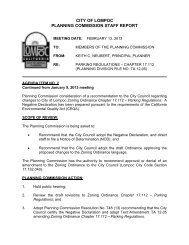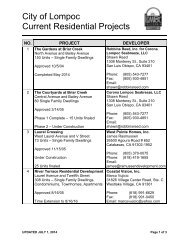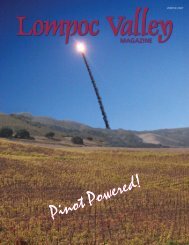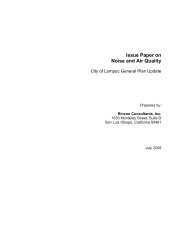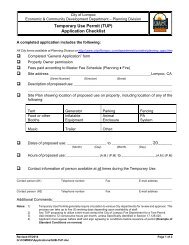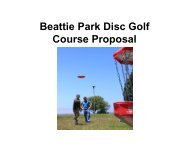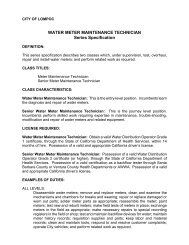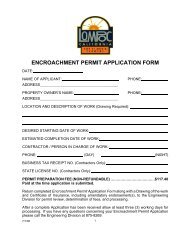Storm Water Pollution Prevention Plan (SWPPP) - the City of Lompoc!
Storm Water Pollution Prevention Plan (SWPPP) - the City of Lompoc!
Storm Water Pollution Prevention Plan (SWPPP) - the City of Lompoc!
You also want an ePaper? Increase the reach of your titles
YUMPU automatically turns print PDFs into web optimized ePapers that Google loves.
Maintenance, Inspection and Repair ProgramThe contractor shall use <strong>the</strong> following guidelines for maintenance, inspection, and repair <strong>of</strong> BMPs identified in <strong>the</strong> <strong>SWPPP</strong> incombination with <strong>the</strong> Field Log Sheets.All BMPs must be inspected in accordance with <strong>the</strong> General Permit requirements for <strong>the</strong> associated project type andrisk level 2. In <strong>the</strong> event <strong>of</strong> a BMP failure or shortcoming, design changes to <strong>the</strong> BMP must be madeto avoid a potential violation.BEST MANAGEMENT PRACTICES INSPECTION FREQUENCYMAINTENANCE/REPAIR PROGRAM(BMPs)(all controls)WM04: Spill <strong>Prevention</strong> and ControlWM05: Solid Waste ManagementInspect and verify that activitybased BMPs are in place prior to <strong>the</strong>commencement <strong>of</strong> associatedactivities. While activitiesassociated with <strong>the</strong> BMP are underway, inspect once a week during<strong>the</strong> rainy season and every twoweeks during non‐rainy season toverify continued implementation.Inspect and verify that activitybased BMPs are in place prior to <strong>the</strong>commencement <strong>of</strong> associatedactivities. While activitiesassociated with <strong>the</strong> BMP are underway, inspect once a week during<strong>the</strong> rainy season and every twoweeks during non‐rainy season toverify continued implementation.• Update plan to account for previouslyunknown materials or chemicals.• Regularly inspect areas noted in <strong>the</strong> SPCP toensure equipment is available andprocedures are posted.• Inspect equipment and vehicles for leaks.• Spot‐check material storage and handlingareas for compliance; clean up as necessary.• Ensure containers have proper labeling;label known materials immediately if notlabeled.• Report spills or leaks as required byreportable quantity regulations to <strong>the</strong>proper authorities.• Define local, state, and federal responseagencies and contact appropriate agenciesin <strong>the</strong> event <strong>of</strong> leaks and / or spills.• Repair containment structures, secondarycontainment, and o<strong>the</strong>r perimeter controlsupon signs <strong>of</strong> degradation.• Inspect BMPs subject to non‐storm waterdischarges daily while non‐storm waterdischarges occur.• Inspect construction waste area regularly.• Arrange for regular waste collection.• Inspect BMPs subject to non‐storm waterdischarges daily while non‐storm waterdischarges occur.



